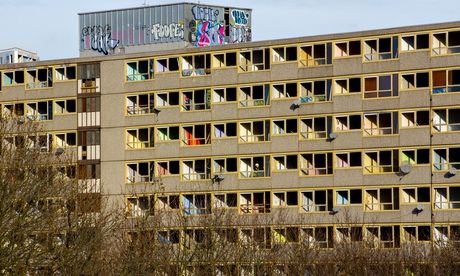221dog_VIABILITY VS COMMERCIAL SENSITIVITY
Residents evicted from the Heygate estate won a two-year battle against Southwark to release the viability assessment made for Lend Lease, the developers. How did they do it?
 The national planning policy framework (NPPF), introduced two years ago, slashed 1,300 pages of policy down to 65 and introduced a “presumption in favour of sustainable development”. But it turns out that it is a form of sustainability that has more to do with the developer’s bank balance than creating sustainable communities or protecting the environment. The principal casualty is the number of affordable homes built. By 2018, there will be a million fewer than in 1980. The NPPF enshrines commercial viability at the very heart of negotiations with the local authority. It says that development proposals “should not be subject to such a scale of obligations and policy burdens that their ability to be developed viably is threatened”. But how viability is determined is the crucial factor. And that is a calculation that happens entirely behind closed doors – and one for which the very people assessing the applications are effectively blindfolded. House-builders, claiming commercial confidentiality which they have lobbied fiercely to protect, obscure the financial modelling used to determine whether a scheme is viable in their eyes. It is shielded from the council and entirely hidden from public gaze. Broadly, the assessment subtracts building costs from projected revenue, while safeguarding a 20% profit margin. The slightest tweak of a single variable can prove that a project would simply be financially unworkable if the required affordable housing quota was fulfilled. Independent analysis shows that profits are routinely underestimated, costs overstated, and the number of affordable homes relentlessly driven down. Councils simply don’t have the in-house expertise to scrutinise these reports and they rarely commission independent assessments. When they do, they are forced to rely on the very consultants used by the property industry, who are loth to contradict their paymasters. But after several community groups succeeded in getting the books opened up on major regeneration schemes across London, the dark art of fiddling viability figures is under increasing public scrutiny. Residents evicted from the Heygate Estate won a two-year battle against Southwark to release the viability assessment made for Lend Lease, the developers. The report justified the controversial plan to replace 1,200 mainly social-rented homes with over 2,300 units, of which a mere quarter will be classed as affordable. Initial findings by critics of the scheme suggest the report grossly undervalued the development. At Capco’s redevelopment of Earls Court in west London, barely one in 10 of the 7,000 new homes will be affordable and none will be for social rent. An assessment commissioned by opponents of the scheme found that the developer’s valuations were “warped”. The same meagre sharewas proposed for the Royal Mail site at Mount Pleasant in north London, although an independent report suggested that in such a high house price area, half the housing could be affordable. Until viability calculations are published, councils will be powerless to stop this great housing con trick. — This post was a re-mix of the original Guardian post whereby the original photo caption has become our headline.
The national planning policy framework (NPPF), introduced two years ago, slashed 1,300 pages of policy down to 65 and introduced a “presumption in favour of sustainable development”. But it turns out that it is a form of sustainability that has more to do with the developer’s bank balance than creating sustainable communities or protecting the environment. The principal casualty is the number of affordable homes built. By 2018, there will be a million fewer than in 1980. The NPPF enshrines commercial viability at the very heart of negotiations with the local authority. It says that development proposals “should not be subject to such a scale of obligations and policy burdens that their ability to be developed viably is threatened”. But how viability is determined is the crucial factor. And that is a calculation that happens entirely behind closed doors – and one for which the very people assessing the applications are effectively blindfolded. House-builders, claiming commercial confidentiality which they have lobbied fiercely to protect, obscure the financial modelling used to determine whether a scheme is viable in their eyes. It is shielded from the council and entirely hidden from public gaze. Broadly, the assessment subtracts building costs from projected revenue, while safeguarding a 20% profit margin. The slightest tweak of a single variable can prove that a project would simply be financially unworkable if the required affordable housing quota was fulfilled. Independent analysis shows that profits are routinely underestimated, costs overstated, and the number of affordable homes relentlessly driven down. Councils simply don’t have the in-house expertise to scrutinise these reports and they rarely commission independent assessments. When they do, they are forced to rely on the very consultants used by the property industry, who are loth to contradict their paymasters. But after several community groups succeeded in getting the books opened up on major regeneration schemes across London, the dark art of fiddling viability figures is under increasing public scrutiny. Residents evicted from the Heygate Estate won a two-year battle against Southwark to release the viability assessment made for Lend Lease, the developers. The report justified the controversial plan to replace 1,200 mainly social-rented homes with over 2,300 units, of which a mere quarter will be classed as affordable. Initial findings by critics of the scheme suggest the report grossly undervalued the development. At Capco’s redevelopment of Earls Court in west London, barely one in 10 of the 7,000 new homes will be affordable and none will be for social rent. An assessment commissioned by opponents of the scheme found that the developer’s valuations were “warped”. The same meagre sharewas proposed for the Royal Mail site at Mount Pleasant in north London, although an independent report suggested that in such a high house price area, half the housing could be affordable. Until viability calculations are published, councils will be powerless to stop this great housing con trick. — This post was a re-mix of the original Guardian post whereby the original photo caption has become our headline.
SAY WHAT_!?

